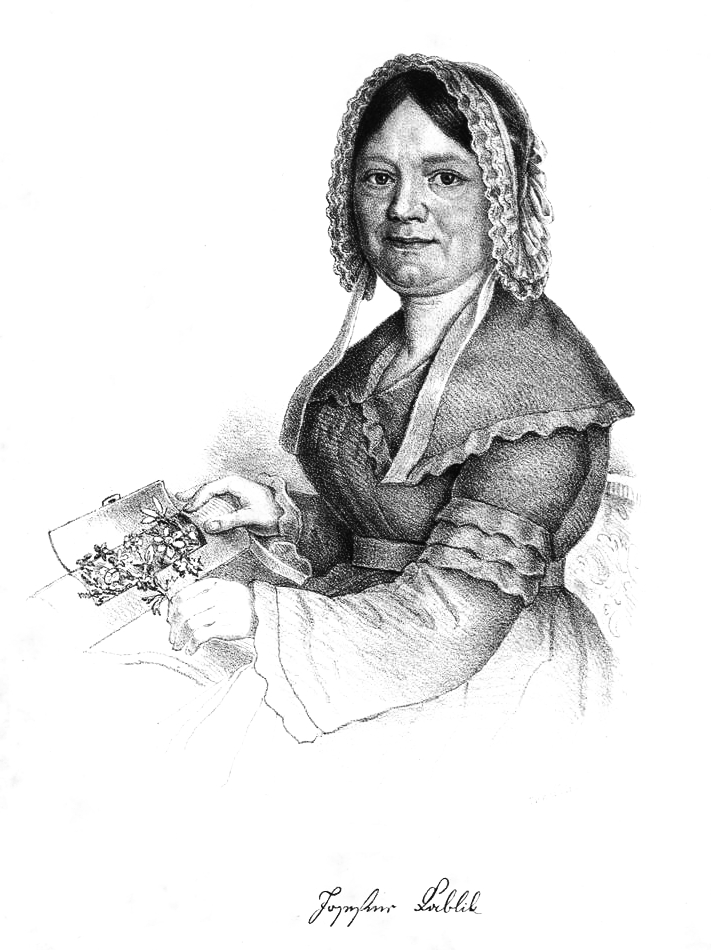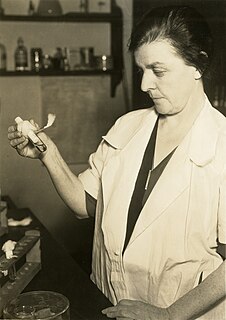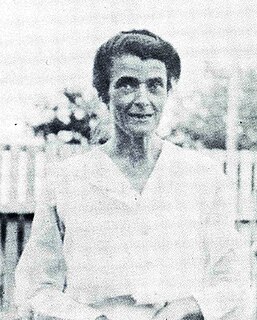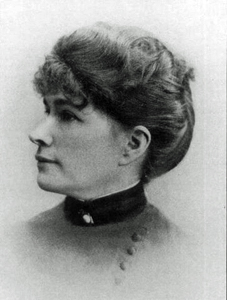Related Research Articles

E. Lucy Braun was a prominent botanist, ecologist, and expert on the forests of the eastern United States who was a professor of the University of Cincinnati. She was the first woman to be elected President of the Ecological Society of America, in 1950. She was an environmentalist before the term was popularized, and a pioneering woman in her field, winning many awards for her work.

Josephine Ettel Kablick was a pioneering Czech botanist and paleontologist. Kablick studied under the best botanists of her time. She collected plant and fossil samples for institutions throughout Europe. Many of the fossils and plants she collected are named in her honor.

Harriet Margaret Louisa BolusnéeKensit was a South African botanist and taxonomist, and the longtime curator of the Bolus Herbarium, from 1903. Bolus also has the legacy of authoring more land plant species than any other female scientist, in total naming 1,494 species.

Mary Katharine "Kate" Brandegee was an American botanist known for her comprehensive studies of flora in California.

Flora Wambaugh Patterson (1847–1928) was an American mycologist, and the first female plant pathologist hired by the United States Department of Agriculture. She ran the US National Fungus Collections for almost thirty years, radically growing the collection and shaping its direction, and supervised or discovered numerous significant fungal diseases.

Agnes J. Quirk (1884–1974) was an American bacteriologist, plant pathologist, and inventor. She oversaw the culturing of bacteria in the Laboratory of Plant Pathology at the United States Department of Agriculture's Bureau of Plant Industry. She received a patent for the production of penicillin mold and jelly in 1952.
Mary A. Albertson, born Mary Ann Mitchell, was an American botanist and astronomer. From 1904 to 1914, she curated the Maria Mitchell memorial located on Nantucket Island, Massachusetts. Her work there covered both the nascent botany department and the astronomical observatory. In the botany department, she curated an herbarium of Nantucket plants, in memory of her cousin Mitchell's love of flowers. She died in 1914 on Nantucket Island.

Mary Sophie Young was a botanist at the University of Texas significant for her field trips where she collected large quantities of specimens making her a key contributor to plant taxonomy in Texas.
Frederica "Freda" Detmers was an American botanist.
Lois Lampe was an American botanist and educator. She taught at various levels for nearly 50 years at the Ohio State University before retiring and becoming assistant professor emerita in 1966. She was a member of six scientific societies and four honors societies during her teaching career.
Mary Agard Pocock was a South African phycologist.
Lady Charlotte Murray was a Scottish botanist and author. She was the eldest child of John Murray, 3rd Duke of Atholl, and Charlotte Murray, Duchess of Atholl. Her paternal grandfather was the Jacobite general Lord George Murray while her maternal grandfather was the Hanoverian James Murray, 2nd Duke of Atholl.
Mary Alice Eleanor Richards (1885–1977) was a British botanist. Born near Dolgellau, Wales, and mainly raised in Lichfield, Staffordshire, UK, she took an early interest in natural history and studied botany part-time at Mason Science College. She married Maj Henry Richards and traveled extensively, including visits to India, Malaysia, China, Japan, Canada, and the United States of America.
Lumina Cotton Riddle (1871–1939) was an American botanist. She was a direct descendant of John Cotton.
Eva M. Reed was an American botanist.

E. Katharine Dooris Sharp (1846–1935) was an American botanist, poet, and suffragist. She was the author of Summer in a Bog.
Emilia Frances Noel was a British botanist, author and illustrator.
Marian Muriel Whiting was a British horticulturalist and plant collector, notable for collecting plants from Hong Kong and Guangzhou. She was born in London and spent a portion of her childhood in Hong Kong before studying at London University. Over 600 of her specimens were donated to the Kew Botanical Gardens. In 1940, she became a Fellow of the Linnean Society of London, and volunteered at Kew for many years. The standard author abbreviation Whiting is used to indicate this person as the author when citing a botanical name.
Mary Letitia (Green) Sprague (1886–1978) was a British botanist and bibliographer at Kew Gardens. In 1938 she married Scottish botanist Thomas Archibald Sprague, the Deputy Keeper of the Kew Herbarium, and together they compiled several supplements to the Index Kewensis. She was an expert on Loranthaceae. The standard author abbreviation M.L.Green is used to indicate this person as the author when citing a botanical name.
Isobel Agnes Arbuthnot (1870–1963) was an Irish-born botanist and botanical collector based in South Africa.
References
- ↑ Joy Harvey and Marilyn Ogilvie (1 January 2000). Laughlin, Emma Eliza. The Biographical Dictionary of Women in Science. Vol. 2. Marilyn Ogilvie and Joy Harvey (editors). New York and London: Routledge. p. 751-JH/MBO. ISBN 978-0-415-92040-7.